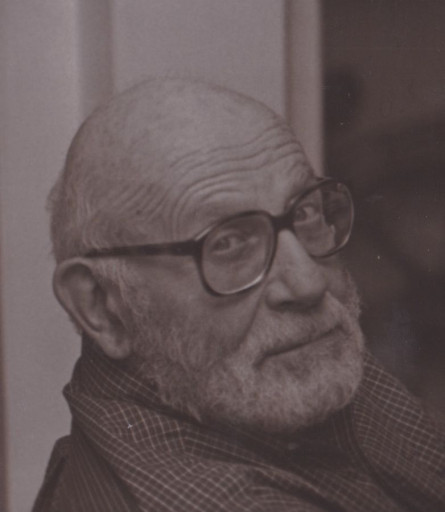

Sy Kattelson
February 11, 1923 — November 24, 2018
Sy Kattelson passed away on November 24th, 2018 in Rhinebeck, New York.
Sy was a photographer whose earliest work documents working class New Yorkers during the years immediately following World War Two. He was an early practitioner of Street Photography and was associated with the Photo League from 1947 until its closing in 1951. His portraits, frequently taken while traveling through the streets or riding the New York City's subways, convey the dignity of his subject's lives. The depth of his photographs often comes from the tension between the grittiness of their urban settings and the contemplative sense of his subjects' as private individuals in a public space. Vivien Raynor, writing in the New York Times, has said, "Mr. Kattelson's weakness - if it can be called that - is his respect for the strangers he photographs... His presence is never felt, but his inquiring yet merciful sensibility is everywhere."
Sy was also known as the original founder of the Tinker Street Cinema in Woodstock, New York, one of the first art house cinemas outside a major urban area. Sy first began showing movies shortly after his move to Woodstock in 1961, first at the Woodstock Artist's Guild then at the Woodstock Town Hall. The cinema found a permanent home when he renovated a church West of the village on Tinker Street, creating a home for himself and his daughter Raina in the adjacent parsonage. Before opening the Cinema, Sy used his expertise in color balancing to develop realistic skin and wound colors for the first moulage products made by the Simulaids company. Sy taught himself clarinet, saxaphone and harmonica and was a member of Holly Cantine's Woodchuck Hollow Brass and Woodwind Choir. In later life, Sy taught himself website design and created a site to showcase his photographs.
Sy was born on February 11, 1923 in the Bronx to Robert and Bertha Kattelson. His mother owned a lingerie shop and his father was an electrician and fabricator of neon signs. His paternal grandfather was a vaudeville musician whose lifestyle influenced his decision to become an artist. Until he was 7 years old they lived on Mount Eden area of the Grand Concourse and then moved to a house in Laurelton, Queens. In 1936 they lost the family store and returned to the Bronx, eventually settling in what was then the working-class neighborhood of Manhattan's Washington Heights. He attended Stuyvesant High School, intending on becoming an aeronautical engineer, but abandoned this direction on learning that there were few jobs in engineering being given to Jews at that time.
It was while working as a delivery boy for the Aremac Camera store on 43rd Street that he first became aware of the possibility of working professionally as a photographer. A German refugee couple who were the owners of a studio to which he was making a delivery on sensing his interest in their work encouraged him to pursue photography. He later worked in the dark room at Stone-Wright Studio and then became the assistant to one of their in-house photographers. This was followed by his becoming the photographer at Lawrence Studios- where he photographed scenes staged by illustrators who would then use his work as the basis for their illustrations in magazines such as 'True Story', 'Cosmopolitan' and 'Romance'.
Rather than wait to be drafted, in 1942 he volunteered for the Air Corps as a corporal aerial cartographer, developing film taken from aircraft to assess the success of their bombing runs. At the war's end he was redeployed to France where he worked as an army publicity photographer.
Upon his return to the United States, Sy joined the Photo League and studied under Sid Grossman and Paul Strand and later was enrolled in the Hans Hofmann School of Art. His work was represented in the original 'This is the Photo League' exhibit of 1948 and the 'New Workers' exhibit of 1949. He taught the Basic Technique and Advanced Technique classes in 1949 and 1950 respectively. He served as an executive member and teacher at the Photo League until it disbanded in 1951 during the Red Scare after being declared "subversive" and a front for the Communist Party. The League, while not directly allied with the Communist Party, was originally named the Workers Film and Photo League and had its origins in Europe as the "Workers as Photographers" movement and counted among its members many that were socially and politically progressive. Writing about that period of his life, Sy has said, "I remember people arguing about whether photography was a serious art form. The Photo League talked about it the way I thought about it, as a serious art form showing ordinary people's lives." The group's political leanings, he said, were never his concern. "I was just trying to show the world what it was."
From 1953 to 1955 Sy worked as a fashion photographer for Glamour and for Fashion and Travel where his experience in street photography led him to be one of the first to use a 35mm camera to photograph models in outdoor urban settings. He photographed the first Newport Jazz Festival in 1954. In 1958 he became a color darkroom technician and manager at a large commercial color photography lab. During the late fifties and early sixties, Sy mastered the painstaking and almost forgotten technique of Carbon print color processing, which makes use of multiple layers of emulsion to create densely saturated, painterly color photographs.
Sy's photographs are included in the collections of the Museum of Modern Art, the National Portrait Gallery, The Museum of Fine Arts in Houston Texas, The Art Institute of Chicago, The New York Transit Museum, The Jewish Museum of New York, The Smithsonian National Museum of African American History and Culture, The National Gallery of Canada and The Musee d'Art Moderne, Saint Etienne, France. His 1948 portrait of Asa Philip Randolph, taken during Randolph's civil disobedience campaign to desegregate the nation's armed forces, was featured in the traveling Civil Rights exhibit Let Your Motto Be Resistance. Sy's work has been represented by the Witkin Gallery and, since 1992, by the Howard Greenberg Gallery in New York.
After selling the Tinker Street Cinema, Sy returned to New York City in the 1980's to continue making photographs, producing a second body of work that captures the dynamism of the city through unusual angles, multiple exposures and collage techniques. Sy moved back to the Hudson Valley in 1992, living first in Saugerties and then at the Baptist Home at Brookmeade, in Rhinebeck. For three years he was lovingly cared for by the staff there and passed away peacefully after a slow and gentle decline.
Sy was married to Estelle Haber, a writer, puppeteer, and political activist, from 1960 to 1968. He is survived by their daughter, Raina Kattelson, his son-in-law, Bob Butscher, and grandchildren, Maeve and Romi Butscher, all of Red Hook, New York, and his grandson, Jason Butscher or Brooklyn, New York. He will be remembered and sorely missed by his family and their close-knit circle of friends, by the staff at the Baptist Home and by the many people who have been enriched by his photographs, the films he showed and his generous and stimulating presence.
Guestbook
Visits: 26
This site is protected by reCAPTCHA and the
Google Privacy Policy and Terms of Service apply.
Service map data © OpenStreetMap contributors


